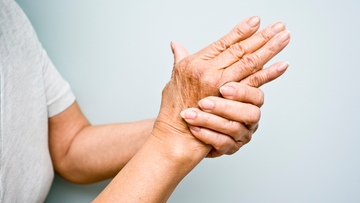Rheumatoid arthritis (RA) is a chronic inflammatory disorder primarily impacting joints, causing pain, swelling, stiffness, and reduced mobility. It results from the immune system's mistaken attack on the body's own tissues, leading to inflammation in the joint-lining membrane, or synovium. This inflammation can progressively damage bones and cartilage, leading to lasting joint deformities and disability.
Understanding Rheumatoid Arthritis (RA)
 Rheumatoid arthritis (RA) is a chronic autoimmune disease that primarily affects joints. In this condition, the immune system mistakenly targets and attacks healthy joint tissue, leading to inflammation. The inflammation that characterizes RA can cause pain, stiffness, and swelling in the joints, negatively impacting the quality of life for those affected by the disease.
Rheumatoid arthritis (RA) is a chronic autoimmune disease that primarily affects joints. In this condition, the immune system mistakenly targets and attacks healthy joint tissue, leading to inflammation. The inflammation that characterizes RA can cause pain, stiffness, and swelling in the joints, negatively impacting the quality of life for those affected by the disease.
As an autoimmune disorder, the exact cause of RA is not entirely understood. However, it is believed that a combination of genetic and environmental factors may contribute to its development.
While there is currently no cure for RA, various treatment options can help manage symptoms and slow down the progression of the disease.
Symptoms of Rheumatoid Arthritis
Joint stiffness is a common morning experience, and as the disease advances, this stiffness might persist, impacting larger joints such as wrists, knees, and elbows.
Pain typically worsens with physical activity and could be accompanied by warmth and tenderness. Occasionally, pain persists even during periods of rest.
Swelling, commonly found in the hands and feet, may make gripping objects or walking challenging and might contribute to deformities.
Fatigue, often characterized as an overwhelming tiredness, can hinder daily activities and diminish overall quality of life.
Lifestyle Changes for RA
Living with rheumatoid arthritis (RA) can be challenging. However, making some key lifestyle adaptations can significantly improve one's quality of life. These adaptations center around exercise, diet, rest, stress management, and maintaining a healthy weight.
Exercise plays a crucial role in improving RA symptoms. It strengthens muscles and increases flexibility, thereby reducing stress on the joints. It is important to engage in low-impact activities such as swimming, walking, and cycling. Gentle stretching, yoga, and tai chi can also help improve joint mobility and range of motion.
A balanced diet is important for overall health and can help manage RA. Including foods rich in anti-inflammatory properties such as fish, nuts, and fruits can offer potential benefits. It is equally important to avoid inflammatory foods like processed items, red meat, and sugar.
Prioritizing rest is crucial for individuals with RA. Adequate sleep helps the body recharge and repair, thus minimizing inflammation and pain.
Effectively managing stress is another important aspect of RA treatment. High stress levels can exacerbate RA symptoms and trigger inflammation. Mindfulness practices, such as meditation, deep breathing exercises, and progressive muscle relaxation techniques, can help alleviate stress.
Maintaining a healthy weight is crucial, as excess weight can place more stress on the joints, worsening RA symptoms.
Managing Pain in Rheumatoid Arthritis
Medications often play a crucial role in pain management for RA patients. Analgesics, including nonsteroidal anti-inflammatory drugs (NSAIDs) like ibuprofen, can help reduce pain and inflammation. For more severe cases, prescription medications like corticosteroids and disease-modifying anti-rheumatic drugs (DMARDs) can provide long-term pain relief and slow down the progression of the disease.
In addition to medications, lifestyle changes can also contribute to pain relief. Maintaining regular exercise and physical therapy can help improve joint mobility, strengthen muscles, and lessen chronic pain. It's advised to consult a healthcare professional to develop a personalized exercise plan that meets individual needs.
Alternative or complementary therapies might offer additional pain relief for some individuals with RA. Examples of such therapies include acupuncture, massage, and heat or cold treatments.
(Experience relief and comfort with Benefab's Therapeutic Fingerless Gloves – a soothing solution to help ease the challenges of living with RA.)
Dietary changes may contribute to pain management in rheumatoid arthritis as well. Incorporating foods that are rich in omega-3 fatty acids, such as fatty fish like salmon, can help reduce inflammation.
Alternative Therapies for RA Relief
Acupuncture is a traditional Chinese practice in which thin needles are inserted into specific points in the body to stimulate the body's natural healing processes. This therapy may help reduce inflammation and regulate the immune system, both of which are beneficial for those with RA.
Massage therapy can help alleviate muscle tension and improve blood circulation, which can contribute to reducing pain levels in those affected by RA.
Tai Chi is a gentle form of exercise rooted in martial arts and involves slow, precise movements combined with deep breathing techniques. Practicing Tai Chi can improve flexibility, balance, muscle strength, and overall mind-body connection.
Breathing exercises play a crucial role in managing pain and stress associated with RA. Slow, deliberate breathing, such as diaphragmatic and pursed-lip breathing, can help activate the body's natural relaxation response.





















